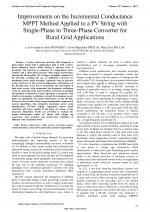| 1/2019 - 9 |
| Extra paper information in |
| Click to see author's profile in |
| Download PDF |
Author keywords
rural areas, static power converters, power system dynamics, solar power generation, iterative algorithms
References keywords
electronics(17), power(15), phase(12), industrial(9), single(7), photovoltaic(7), energy(7), systems(6), converter(6), grid(5)
Blue keywords are present in both the references section and the paper title.
About this article
Date of Publication: 2019-02-28
Volume 19, Issue 1, Year 2019, On page(s): 63 - 70
ISSN: 1582-7445, e-ISSN: 1844-7600
Digital Object Identifier: 10.4316/AECE.2019.01009
Web of Science Accession Number: 000459986900009
SCOPUS ID: 85064206464
Abstract
A power electronic interface that integrates a photovoltaic string with a single-phase grid to feed a three-phase induction motor, while driving a fan-type load, is presented. The interface is composed of a single-phase active rectifier and a three-phase inverter with output transformer, wherein the Photovoltaic (PV) string is straightly connected to the DC-link, avoiding the use of additional converter for maximum power point tracking, commonly seen in previous works. However, in this system configuration, disturbances at the DC-link may occur due to increments and decrements of load active power, with consequent low-frequency oscillations at the AC grid side of the active rectifier. Therefore, a modified Incremental Conductance based algorithm is proposed, with which low-frequency oscillations around the maximum power point are minimized even under disturbances at the DC-link. Moreover, the overall system energy management, composed of control algorithms, that integrates maximum power point identification , DC-link voltage regulation, motor speed controller and power quality at the input AC mains, is also proposed. Simulation results are provided to evaluate the system effectiveness under AC mains with voltage sag occurrence, load transient and steady-state conditions at different solar irradiance levels. |
| References | | | Cited By |
Web of Science® Times Cited: 3 [View]
View record in Web of Science® [View]
View Related Records® [View]
Updated today
SCOPUS® Times Cited: 6
View record in SCOPUS® [Free preview]
View citations in SCOPUS® [Free preview]
[1] Analysis of the Hybrid PSO-InC MPPT for Different Partial Shading Conditions, LEOPOLDINO, A. L. M., FREITAS, C. M., MONTEIRO, L. F. C., Advances in Electrical and Computer Engineering, ISSN 1582-7445, Issue 2, Volume 22, 2022.
Digital Object Identifier: 10.4316/AECE.2022.02004 [CrossRef] [Full text]
[2] A Review on Power Electronics Technologies for Power Quality Improvement, Afonso, Joao L., Tanta, Mohamed, Pinto, José Gabriel Oliveira, Monteiro, Luis F. C., Machado, Luis, Sousa, Tiago J. C., Monteiro, Vitor, Energies, ISSN 1996-1073, Issue 24, Volume 14, 2021.
Digital Object Identifier: 10.3390/en14248585 [CrossRef]
[3] Reliability and losses investigation of photovoltaic power generators during partial shading, Satpathy, Priya Ranjan, Sharma, Renu, Energy Conversion and Management, ISSN 0196-8904, Issue , 2020.
Digital Object Identifier: 10.1016/j.enconman.2020.113480 [CrossRef]
Disclaimer: All information displayed above was retrieved by using remote connections to respective databases. For the best user experience, we update all data by using background processes, and use caches in order to reduce the load on the servers we retrieve the information from. As we have no control on the availability of the database servers and sometimes the Internet connectivity may be affected, we do not guarantee the information is correct or complete. For the most accurate data, please always consult the database sites directly. Some external links require authentication or an institutional subscription.
Web of Science® is a registered trademark of Clarivate Analytics, Scopus® is a registered trademark of Elsevier B.V., other product names, company names, brand names, trademarks and logos are the property of their respective owners.
Faculty of Electrical Engineering and Computer Science
Stefan cel Mare University of Suceava, Romania
All rights reserved: Advances in Electrical and Computer Engineering is a registered trademark of the Stefan cel Mare University of Suceava. No part of this publication may be reproduced, stored in a retrieval system, photocopied, recorded or archived, without the written permission from the Editor. When authors submit their papers for publication, they agree that the copyright for their article be transferred to the Faculty of Electrical Engineering and Computer Science, Stefan cel Mare University of Suceava, Romania, if and only if the articles are accepted for publication. The copyright covers the exclusive rights to reproduce and distribute the article, including reprints and translations.
Permission for other use: The copyright owner's consent does not extend to copying for general distribution, for promotion, for creating new works, or for resale. Specific written permission must be obtained from the Editor for such copying. Direct linking to files hosted on this website is strictly prohibited.
Disclaimer: Whilst every effort is made by the publishers and editorial board to see that no inaccurate or misleading data, opinions or statements appear in this journal, they wish to make it clear that all information and opinions formulated in the articles, as well as linguistic accuracy, are the sole responsibility of the author.



